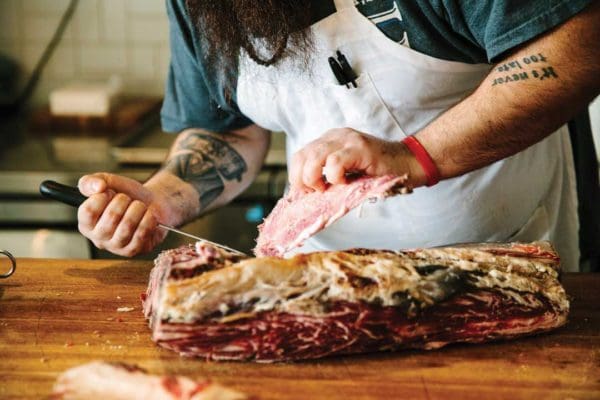Food: A fusion of cultures {Vixen’s Wedding}
Vixen’s Wedding ties together cultures with a twist.
Words by Jessi Devenyns Photos by Shelby Bella
Despite oft intertwined associations of countries and cuisine, there was a time when there were no tomatoes in Italy, no chilies in India, and no potatoes in Ireland. Then, half a millennia ago, a small country changed the modern conception of world cuisine.
Portugal has had outsized influence on cuisine, according to Chef Todd Duplechan of Vixen’s Wedding, and the recurring traces of the country’s travels that traversed hemispheres and latitudes piqued his curiosity. However, it took years of scrapped concepts and a change in climate before this native Texan was able to open the doors to Vixen’s Wedding where he offers dishes that serve as an anthropological exploration in the evolution of flavors.
Todd explains that “[Northern India] was gifted to the British by the Portuguese, but they kept [Goa] … where they remained there for 500 years.” Centuries of interchanging cultures had lasting influence on what is today considered Indian fare. Case in point is vindaloo sauce. “‘Vindaloo is a Portuguese name that’s been taken and turned into an Indian word,” says Todd. The root ‘vin’ comes from the Latin word for wine and describes the wine-based braising method that is integral to the now familiar curry sauce.
The fusion of cultures is what first intrigued Todd about Goan cuisine. However, replication of an established culinary tradition was not enough, so the chef incorporated one final ingredient to create a truly Texan concept: local produce. “So, you’re not going to go to Goa and find dishes like you find on the menu here,” he clarifies. Instead, the southern, subtropical style food and Iberian peninsula spice is reinterpreted for Texan palates, which are primed for spices and acidity. “Because these are the foods you should be eating in a hot climate,” reasons Todd. “Not a lot of cream, not a lot of butter, but spicy, acidic, and citrusy. That kind of stuff makes sense with their weather.”
Evidence of the happy marriage between these three cultures arrives in a savory cauldron of steamed mussels. The salty brine of shellfish laps alongside chor-izo in a curry broth that begs to be sopped up by one of the airy, heritage grain breads.
Seafood once again makes a splash with the dashing presentation of a whole roasted fish. The spicy smokiness of the green curry sauce is reminiscent of barbecue, while the flaky white fish that is dotted with fronds of cilantro and lardo is a bow to fish tacos. The combination is at once as comforting as it is engaging for the taste buds.
Perhaps the most noteworthy is also the most humble dish. Much like Texan cuisine has elevated corn and flank steak to be a signature of its culinary makeup, Vixen’s Wedding reimagines beets as a centerpiece dish. Called tortured beets – according to Todd “they kind of go through hell” when they are boiled in vinegar, smoked, and charred – these red gems are scented with curry leaf aioli and accompanied by a lentil dosa bread. The medieval nomenclature used in the description of the dish belies the subtle result that touches all six taste sensations simultaneously.
The array of ingredients at Vixen’s Wedding is meant to be both an invitation to a new culture and a reintroduction to the one that created Austin’s cuisine. The menu also includes vindaloo ribs and coconut salad which are in many ways reminiscent of the familiar ribs and coleslaw. Similarly, chaat fried green tomatoes are an elevated version of a summertime favorite. It all makes sense; it just takes that first bite.

What’s in a Name?
The name Vixen’s Wedding was inspired by a Portuguese parable where a fox and a wolf are married under a sun shower to illustrate how a seemingly unnatural pairing can find beauty through its union. Sun showers often bring along rainbows.
Contact:
(737) 242-7555
1813 A E 6th St.
vixensweddingatx.com
@vixensweddingatx


















